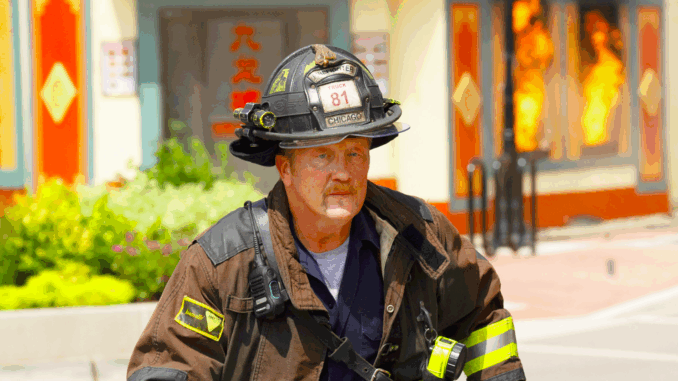
When Chicago Fire premiered in 2012, it promised to deliver explosive drama, compelling characters, and edge-of-your-seat rescues. Over a decade later, it has done all that—and something more subtle but far more powerful. The show has become one of television’s most consistent tributes to real-life firefighters, EMTs, and first responders. Through its gripping storytelling and behind-the-scenes dedication to accuracy, Chicago Fire doesn’t just dramatize danger—it dignifies those who face it every day.
Grounded in Reality
One of the key ingredients in the show’s long-running success is its commitment to realism. From the beginning, creator Dick Wolf and the production team worked closely with consultants from the Chicago Fire Department. The technical advisors on set aren’t just hired for authenticity—they’re often former or current firefighters themselves.
Every action sequence, whether it’s a structure blaze, vehicle extraction, or hazardous material incident, is meticulously choreographed. The gear is real. The terminology is accurate. The risks depicted on screen are based on situations actual firefighters have faced.
This commitment to realism doesn’t just serve drama—it builds trust with the show’s audience, many of whom include firefighters, EMTs, and their families.
The Ride-Along Stories That Shape Each Episode
Before new actors step into their gear, they often participate in ride-alongs with actual firehouses in Chicago. Jesse Spencer (Matt Casey), Taylor Kinney (Severide), Miranda Rae Mayo (Kidd), and others have all trained with real teams, responding to live calls, carrying hoses, and feeling the heat.
What they see informs their performances—but it also informs the writers. Many plotlines begin not in a writers’ room, but in the back of an ambulance or a fire truck, as cast and crew listen to real stories of triumph, heartbreak, and survival.
Some of the show’s most iconic moments—saving a baby from a burning building, responding to a mass casualty incident, or navigating the psychological toll of constant trauma—are drawn directly from those ride-along experiences.
Honoring the Fallen, Respecting the Living
Chicago Fire doesn’t glamorize death. When characters die on screen, the pain is shared—by viewers, by the characters, and, most importantly, by the writers who understand what those scenes mean to people watching who’ve lived it in real life.
The death of firefighter Brian “Otis” Zvonecek in Season 8 was one such moment. He died in the line of duty, protecting others. The aftermath wasn’t brief or brushed over—it spanned episodes, affecting every member of Firehouse 51. That approach mirrored the real process of mourning within a close-knit firehouse, where losing one means losing part of a whole.
For viewers with loved ones in uniform, those scenes strike deep. They’re not just fiction—they’re recognition.
Firehouse 51 as a Mirror of the Real World

In real firehouses, diversity of experience, culture, and personality is the norm. Chicago Fire reflects that with increasing nuance. Over the years, characters like Stella Kidd, Joe Cruz, and Violet Mikami have emerged not just as representatives of underrepresented groups, but as complex professionals navigating leadership, loss, and love in a high-stakes world.
The show avoids clichés. Instead of reducing these characters to tropes, it explores how race, gender, and class intersect with the fire service without becoming the sole focus. That balance is what makes it feel authentic—and what makes it resonate with so many viewers who see themselves, or their loved ones, in those stories.
Spotlighting Community and Courage
Beyond the emergency calls, Chicago Fire shines when it slows down. The kitchen scenes. The post-call debriefs. The moments of silent grief. These aren’t filler—they’re the soul of the show.
They reflect what real first responders often say: that the hardest part isn’t the danger, it’s what comes after. The sleepless nights. The broken families. The bonds that form between people who’ve survived trauma together.
By showing both the physical and emotional toll, Chicago Fire offers one of the most complete portrayals of what it means to serve.
A Legacy Beyond the Screen
More than just a hit TV show, Chicago Fire has become part of the cultural conversation around public service. The show has inspired viewers to pursue careers in emergency response. It has helped fundraisers and awareness campaigns for burn victims, first responder mental health, and firefighter safety. Its stars regularly participate in community events and real-world initiatives related to fire safety and rescue work.
And through its storytelling, it has given millions a closer look at the daily acts of courage that often go unseen.
Conclusion: Television With a Purpose
In an era of endless TV options, Chicago Fire has lasted not because of spectacle, but because of substance. The show respects the badge. It respects the risks. And it respects the men and women who, every day, choose to walk into danger when the rest of us run away.
Fire may be the backdrop. But humanity is the message.
